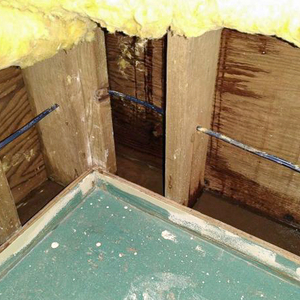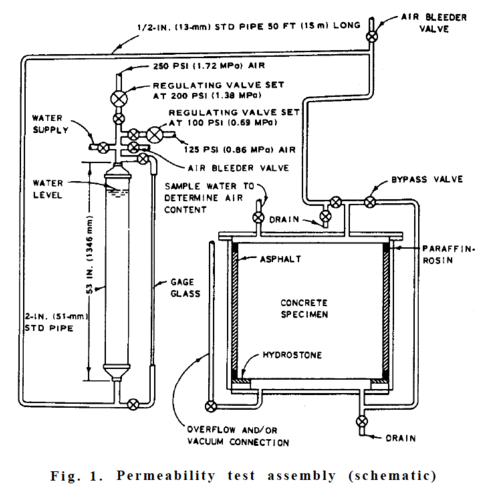
Early morning TV viewers in Portland, Maine, sooner or later will meet Tony Hafford, founder of T.C. Hafford Basement Systems. The affable pitchman stands beneath an oversized umbrella and promotes a business devoted to “all things basementy.” Hafford is one of hundreds, maybe thousands, of specialists around the country who have made careers out of rehabbing wet, moldy basements and crawlspaces. But few in the business would argue that even a successful retrofit is better than keeping water out of the basement in the first place.
“It’s always better to treat the exterior,” says Peter Barrett, product and marketing manager for Dörken Systems Inc., which makes a variety of waterproofing products. “It’s always better to try to keep the water out of the system than manage the water once it gets into the system.”
Expectations for below-ground spaces continue to rise, as building scientist John Straube points out in this webinar at Dörken’s website. Homeowners at one time expected their basements to be wet once in a while. Who cared? They were used mainly for storing coal and potatoes. That’s s no longer the case. Basements are increasingly becoming in-law suites, man caves and home theaters where finish materials rival those in above-grade parts of the house, Straube says. And for that, any amount of water is a potentially serious problem.
Products and techniques for managing water infiltration go far beyond the buckets of asphaltic goop that builders spread on below-grade portions of foundation walls. Although that’s still a common approach for dampproofing foundations, builders also will find a range of other products, from peel-and-stick waterproofing membranes to liquid-applied synthetic rubber designed to span cracks in the concrete that are bound to develop in time.
When builders combine these products with below-grade…
Weekly Newsletter
Get building science and energy efficiency advice, plus special offers, in your inbox.

This article is only available to GBA Prime Members
Sign up for a free trial and get instant access to this article as well as GBA’s complete library of premium articles and construction details.
Start Free TrialAlready a member? Log in















8 Comments
Sigh, many of these 'solutions' merely treat the symptoms, not the disease. And many of the 'experts' quoted here are merely marketing flacks who have vested interest in selling you something and are wholly unqualified sources for advice. Consult a competent geotechnical engineer (yes, someone with an engineering degree who is actually trained/licensed to do this work - preferably one who does commercial and public works).
Your first - and most important - target is keeping water away from the foundation in the first place. That means CLEAN well-graded (as in no fines) gravels used as backfill full-height of the wall (12" min width). The synthetic waffle drain products are an attempt to avoid installing gravel - don't fall for the marketing hype - at best waffle board is a secondary backup because of it's tendency to clog over time, it's lack of carrying capacity and it's ease-of-damage (frost heave/expansive soil cycling can shove the drain board out of the ground and backfill/compaction equipment easily tear the material). Around the perimeter, below the foundation floor level (ideally bottom of footing), use solid slotted drain pipe (slots always face down) - Do not use any type of corrugated flex pipe - crushes far too easily. Use long-sweep connectiors. Care should be taken to ensure positive drainage to daylight (if possible - otherwise a sump that will require much more maintenance/overflow sensors/potentially intermittent power backup). In difficult-to-access locations (when construction is complete), consider a second, redundant drain in case issues arise, as the cost to repair will vastly outweigh the cost of running a second drain line. Finally, add cleanouts (use long-sweep connectors only) as needed (typically one at each side of the building). Wrap the pipe and gravels with a quality long-life geosynthetic filter fabric (not the cheap, next-to-worthless landscape fabric)
Do not put unskilled labor in charge of this critical work - nor blithely assume the grading contractor will use clean well-graded gravels (in residential, a safe working assumption is to assume grading contractors are hacks who will take shortcuts unless there is constant onsite supervision). Place a 6" cap of clay soil (or judiciously place impervious surfaces) around the structure's perimeter. Slope surface away from the foundation (accounting for future landscaping). Gutter drains should be connected to site drainage.
If you've been careful with your drainage and backfill, your foundation should remain dry for the life of the building - greatly reducing the load (and cost) of whatever secondary damproofing material you choose. Spend the money treating the disease, not expensive, unreliable attempts to manage symptoms (if water gets to your structure, you've failed - don't be a failure)
Good overview, Scott. In my specs I include a version of the items that Granular mentions above, but those alone do not guarantee a dry foundation; they should just be the baseline for every project. When there is a high water table or silt-laden soil, you need additional protection beyond the code-required damp-proofing. As a designer I have found it virtually impossible on residential projects to get excavators and foundation contractors to follow specs so it's smart to have redundant systems.
VERY good, useful article! Totally agree that preventative, good design and construction practices are worth the investment. And good articles on GBA provide much needed guidance.
A few other minor "preventative" tips, that can be the source of water intrusion into basements:
1. Seamless gutters preferable, one less place to leak between sections of gutter.
2. Clean out your gutters so they don't overflow, allowing water to get to windows or create pools near your foundation. (Or use those pricey gutter guards?)
3. Check your gutters for leaks, debris accumulation, and overflow during intense rain.
4. Consider putting clear plastic covers over any window wells for basement windows. That will deflect water away from accumulating in the window wells. Secure them down so they don't blow away (e.g., with tent stakes).
5. Remember the importance of grading. Slope away from the foundation in all directions to avoid water pooling at the foundation perimeter. Check during intense or long rainy periods. Soils can compact, and subsequent foundation plantings or mulching might change that original grading slope. Over time, some areas may begin to collect water next to the foundation.
Twice I've been asked to fix basement water accumulation following rainstorms, and guess what eliminated the problem? Fixing these items (above) cost a lot less than the fixing the more involved renovation work discussed in the article, which are required for more serious problems. Another contractor had bid to do thousands of dollars of (unnecessary) work inside the basement in one of these two cases, when observation and cheap gutter repair and soil regrading corrected the basement water problem.
Any thoughts on waterproofing admixtures like in the links below? They seem like an almost ideal component of a waterproof foundation, but I've never seen them mentioned in articles/videos on the subject. Presumably that is because they're not cost-effective for residential, but if anyone knows the answer I'd love to hear it.
https://www.kryton.com/products/krystol-internal-membrane-kim/
https://www.xypex.com/products/additive-products
https://hycrete.com/products/waterproofing/hycrete-w1000/
I am writing specs for a foundation bid, and am wondering what is the prudent amount of water/damp proofing for stem wall/spread footing foundation with a slab on grade. There is no basement to worry about, and I do not want to spend an unnecessary amount of money on protecting an area that may not need protection.
There is a high water table, which is my main concern. My thoughts are clean, well graded gravel, perimeter drains, downspouts tight-lined to storm water drain. Wall section attached for reference
ArchitectJudge,
I think what you show will work well. I would eliminate the cant strip on the footing, as it doesn't do much with a slab on grade.
If the main concern is a high water table I would address that separately with trench drains and rock pits as part of the site drainage. If you are concerned about water under the slab, I would place a single run of perforated pipe from the middle of the foundation to the stem-wall, located just above the footings and detailed much as your perimeter drains are - then tie the two together.
Thank you Malcolm, great advice. I will be covering the exterior of the stem walls with 2" GPS insulation. This acts as a hydrostatic pressure break, correct? No need to add a dimple mat or drainage board? If needed, would I place it between the insulation and the stem wall? Could add about $800 material cost to the project that I am looking to avoid if possible
ArchitectJudge,
I don't see much benefit to adding any exterior mat.
Good luck with your build!
Log in or become a member to post a comment.
Sign up Log in